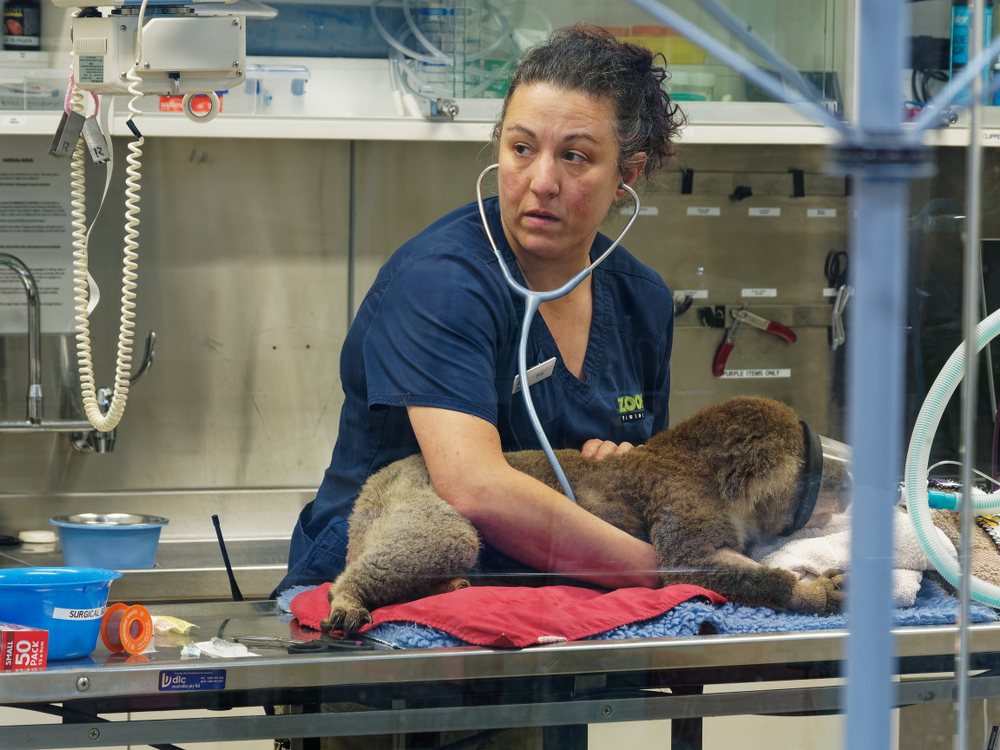This is a complex question. But ultimately, yes, zoos strive to create habitats that will create environments where animals can be cared for.
That is their ultimate mission. For reputable zoos, this is something that they focus on every day.
In order to achieve that mission, zoos employ professionals that have animal science and other university degrees so that they can ensure that the animals in their care are taken care of.
This is a move beyond caging tigers and chimpanzees so that people can come, walk by, and take a look at them.
Zoos today work to educate visitors so that they can understand the animals that they see, their habitats, and how they live in the wild.
Beyond exhibitions and educational opportunities, zoos also actively engage in conservation activities and the rehabilitation of injured animals.
Often visitors do not see these programs in action, though zoos generally publish public information about these efforts to inform the public and potential donors.
At the core of the function of zoos is the animals, and recent years have brought moves to improve conditions for the animals in their care.

Table of Contents
Changes in zoo environments
Over the past hundred years or so, zoos have moved from caged conditions to habitats that resemble savannas or rocky environments that are more like the ones where the animal would live in the wild.
In addition, natural vegetation has been added from the animals’ native habitats.
Lastly, while they also receive proper nutrition, zoos are providing socializing opportunities for those animals that tend to live in groups or social structures.
The essential functions of zoos
These missions begin with the education of the public about animals from around the world.
They do this through public programs and signage that help visitors to understand more about the animals and their behaviors.
The goal is to help people learn about animals and why they are so important.
Another function of zoos is to protect endangered animals. They do this through breeding programs, often in conjunction with other zoos, which strive to ensure the survival of an animal.
The second part of the mission is that they work to educate the public and highlight endangered animals.
The third core function of zoos is to rescue injured animals and rehabilitate them if possible.
Animals who retain their “wild” nature following their recovery are released into the wild. A good example of this is the many bald eagles who have been rehabilitated and released back into the wild.
Prolonging the life of animals through zoo efforts

This may not be true with all zoos, but when an animal is placed in a reputable zoo, they have an 80% chance of living longer than they would in the wild.
There are several reasons for this including appropriate medical care and the reduction of the threat from predators.
For instance, in the wild, an animal might die from a fungal or bacterial infection but can receive needed medications in a zoo.
One of the downsides may be that for naturally migratory animals, such as birds, big cats, zebras, and elephants, there is a limited area where they can roam.
For some animals, though, expert medical treatments and longer lifespans can outweigh roaming.
However, it is still something to consider.
Zoos are not appropriate for all animal species
There are several animals that are difficult to house in zoos. This is to the point that, in some cases, keeping them there can be considered animal abuse.
This is not true for all animals, though, as some following rehabilitation would not be able to survive in the wild due to their injuries.
One example that is often given is polar bears. It is difficult to create a cold climate and the need to roam in a zoo environment.
They risk overheating in mild climates and even mental difficulties in a closed environment.

Another common example is sea mammals such as dolphins, whales, and sea turtles. Many rescued animals would not do well in the open ocean following an injury.
However, due to their higher level of intelligence, they understand the confines of their captivity.
The trend has been for marine parks to cease acquiring new animals for this reason.
Not all zoos are equal
Roadside “zoos” and animal attractions are not known for the beneficial treatment of animals.
Animals are at times kept in poor conditions with limited medical care and less than appropriate nutritional programs.
It is best to not participate with these organizations.
If there are questions about a particular zoo, learn more about its accreditation through the Association of Zoos & Aquariums.
These are professional organizations that strive to fulfill the highest standards for animal organizations.
Also, if an organization focuses on animals are entertainment, it’s best to steer clear.
The focus of zoos in the past
In the 1950s and earlier, the focus of most zoos was to simply display an animal collection to patrons.

Often, this was simply for entertainment purposes. Stories from the era often include ones where animals were captured in the wild (i.e., chimps taken from their mothers) for display in a land far from their own simply because cages needed to be filled.
Today, that focus has changed through the accreditation process for 208 zoos in the United States.
Now, the focus is on education, saving species from extinction, and rehabilitation. This dramatic shift in focus has led to better animal conservation efforts.
The Houston Zoo – leading by example
One effort that the Houston Zoo has undertaken, beyond shifting its focus, is by partnering with the United States Department of Agriculture.
Through this program, the zoo temporarily cares for animals that have been confiscated in illegal importations.
The zoo also cares for injured animals rescued in the wild.
One rescue animal at the Houston Zoo is a Ridley sea turtle. This particular turtle was rescued after a motorboat’s blade cut through its shell and severed its spinal cord.
This has left the turtle with only the use of its front flippers.
Zoo patrons learn about this unique sea turtle during programs at the zoo’s aquarium. During its time of rehabilitation and captivity, it has grown from 15 lbs. to 45 lbs.
Due to the seriousness of the turtle’s injuries, it would not survive in the ocean.
Other injured animals rehabilitated at the Houston Zoo

Sea turtles are often threatened by watercraft, but they are also in danger by the food industry.
For example, over 10,000 tons of turtles are shipped to China each year from Indonesia.
The Houston Zoo helped provide medical care for 7,000 turtles that were confiscated in Hong Kong.
The zoo has also rescued and provided medical care for reptiles and fish around the world.
Reptiles are frequently smuggled. So, too, are many fishes – some endangered – which are rescued as they are en route to Asian markets.
Providing medical care and a safe environment is just a part of what the zoo does on a daily basis. Education is key.
From rehabilitation facilities to education and conservation – the Belize Zoo
Not all zoos begin their lives in exhibitions or educational spaces. A case in point is the Belize Zoo.
The Belize Zoo began as a facility to care for and rehabilitate injured wild animals and those used in documentary films in 1983.
Employees at this backyard “zoo” and facility soon realized that many Belizeans didn’t know very much about the wild animals in their own small nation.
This led the leadership to move beyond rehabilitation and develop a wildlife education center.

Today, the zoo cares for over 200 animals of 45 different species. These are animals who were rescued, rehabilitated, or orphaned.
Through their efforts, they have also created several dynamic conservation programs that operate throughout the country.
The establishment of the Belize Zoo
The zoo formally became a nonprofit, non-governmental agency dedicated to wildlife conservation, rehabilitation, and environmental education.
For many Belizeans and international visitors, this is a chance to see and learn about elusive native animals such as the jaguar, tapir, and toucan – the national bird of Belize.
The zoo also helps visitors understand why the conservation of natural habitats is so important for animals.
This is an important care value as education will lead to animal and habitat protection in the future.
Each year, 86,000 visitors come to the center.
What began as a center for injured animals has grown into a national asset for the animals of Belize.
While the center began as a place for injured animals to receive medical care and recovery treatment, it has grown into a full center with transitional forest and savanna areas for the care of at-risk animals.
The zoo still accepts and provides care for injured wild animals, releasing them when and where it is appropriate.
Further conservation efforts

The Houston Zoo is also noted for breeding programs for endangered animals, including fish and aquatic mammals.
This is an important step as many coral reefs around the world are also having problems that directly impact aquatic populations.
To assist with this issue, the zoo developed a program to propagate coral in their aquatic facilities.
These will be released into the ocean.
Another example is the zoo’s efforts to breed Attwater’s prairie chickens. This type of grouse was almost pushed to extinction along the Texas coast.
When the birds are released into the wild within the Galveston Bay Prairie Reserve, they are tracked by a radio collar so that the population can be monitored.
One significant issue that zoo staff members have to deal with is that these birds bred in captivity don’t know how to survive in the wild.
Adjusting the time of year when the birds are released has given them a greater chance to grow and learn the behaviors needed to avoid predators like hawks.
Steps to prevent the destruction of birds
While not endangered, many birds are killed each year in Indonesia for their feathers that are used for ceremonial purposes.
Fifteen zoos came together to gather the black and white feathers shed from captive birds. These are sent to Indonesia, thus preventing the destruction of a population of birds.
These are a few examples of how zoos have grown to become dynamic organizations committed to the conservation and rehabilitation of animals around the world.

Some efforts may seem small in comparison to the enormity of the effort needed, but they are steps in a positive direction.
Every day, zoo professionals and researchers are working together with colleagues around the world on common goals.
So, yes, zoos do take injured animals and provide rehabilitative care. As one zoo professional at the Houston Zoo said, “We want people to see and know what we’re doing for conservation and rescue efforts, and to teach people about the roles they can play in helping.”
A role that the public plays is educating their friends and family about the importance of wildlife and environmental conservation.
If a wild animal is discovered, it is important that the local zoo be contacted for proper care.
It may seem like a small role to play, but it is vitally important for animals around the world.

















